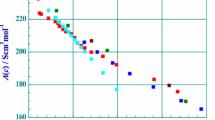Abstract
The concentration curve of mean activity coefficient to the required power was fitted by a product function. The product function can be factorized in factor functions which represent the concentration dependence of the single-ion species (J Solid State Electrochem, in press, 1). With a simplified procedure of this method, it is possible to split the mean activity coefficients into the individual parts for the ionic species within the extended Debye–Hückel concentration range. This method is applicable to all strong electrolytes because it is not necessary to have further data or additional assumptions.

Similar content being viewed by others
Notes
Concerning the case k = lower bound of summation 1 and upper bound of summation 3, the relationship (4) is written in the paper by Ferse and Müller [1] dissolved in summands with a different designation of the parameters:
$$ \gamma_{\pm }^{{{\nu_{ + }} + {\nu_{ - }}}}(J) = \bar{\gamma }_{\text{C}}^{{{\nu_{ + }}}}(J) \cdot \bar{\gamma }_{\text{A}}^{{{\nu_{ - }}}}(J) \approx {\left[ {{c_1}{e^{{{{c'}_7} \cdot {J^{{\frac{1}{2}}}}}}} + {c_3}{e^{{{c_9} \cdot J}}} + {c_5}{e^{{{c_{{11}}} \cdot {J^{{\frac{3}{2}}}}}}}} \right]^{{{\nu_{ + }}}}}{\left[ {{c_2}{e^{{{{c'}_8} \cdot {J^{{\frac{1}{2}}}}}}} + {c_4}{e^{{{c_{{10}}} \cdot J}}} + {c_6}{e^{{{c_{{12}}} \cdot {J^{{\frac{3}{2}}}}}}}} \right]^{{{\nu_{ - }}}}} $$The following values [20] are used after the year 1977: A′ = 1.17625 (A = 0.510839), B = 0.32866; all values are valid for aqueous solutions and a temperature of 298.15 K.
Hamer and Wu [21], for example, used the following relationship (11) for the calculation of the mean activity coefficients but for an extended concentration range:
$$ \log {\gamma_{\pm }} = \frac{{ - {\text{A}}\left| {{z_{\text{C}}} \cdot {z_{\text{A}}}} \right|\sqrt {J} }}{{1 + B*\sqrt {J} }} + \beta \cdot J + C \cdot {J^2} + D \cdot {J^3} + ... $$(11)B*, ß, C, D…: empirical constants, the values are different for all electrolytes.
Note: B* in (11) is not identical with “B \( \tilde{a} \)” in the extended Debye–Hückel Eq. 10!
Extremely high accuracy is certainly not really important. They afford excellent services as operands.
References
Ferse A, Müller H-O (2011) J Solid State Electrochem. doi:10.1007/s10008-011-1413-9
Guggenheim EA (1929) J Phys Chem 33:842–849
Malatesta F (2000) J Solution Chem 29:771–779
Malatesta F (2010) Fluid Phase Equil 295:244–248
Ferse A, Ferse E (1966) Z Chem 6:241–255
Schwabe K, Kelm H, Queck C (1974) Z Phys Chem (Leipzig) 255:1149–1156
Ferse A (2008) Z Anorg Allg Chem 634:797–815
Schwabe K, Ferse A (1962) Die Zuckererzeugung 6:194–198
Ferse A, Schwabe K (1965) Z Phys Chem (Leipzig) 230:20–41
Schwabe K (1967) Electrochim Acta 12:67–93
Ferse A (1977) Z Phys Chem (Leipzig) 258:257–279
Ferse A (1981) Z Phys Chem (Leipzig) 262:977–995
Ferse A, Neumann P (1977) Mathem Operationsforschg und Statistik. Ser Statistics 8:529–543
Monk CB (1961) Electrolytic dissociation. Academic, London, pp. 8 and 30
Bates DM, Watts DG (1988) Nonlinear regression analysis and its applications. Wiley, New York
Neter J, Kutner MH, Nachtsheim ChJ, Wasserman W (1996) Applied nonlinear statistical models, 4th edn. McGraw-Hill, Boston
Seber GAF, Wild CJ (2003) Nonlinear regression. Wiley, New York
Debye P, Hückel E (1923) Physik Z (Leipzig) 24:185–206
Debye P, Hückel E (1923) Physik Z (Leipzig) 24:305–325
Staples BR, Nuttall RL (1977) J Phys Chem Ref Data 6:385–407
Hamer WJ, Wu Y-Ch (1972) J Phys Chem Ref Data 1:1047–1099
Kielland J (1937) J Am Chem Soc 59:1675–1678
Bates RG (1964) Determination of pH. Theory and Practice. John Wiley & Sons, New York
Acknowledgment
I want to express my sincere thanks to Prof. Dr. Waldfried Plieth, Technische Universität Dresden, Germany. This paper could not have been realized without his encouraging interest and his decisive support.
Author information
Authors and Affiliations
Corresponding author
Rights and permissions
About this article
Cite this article
Ferse, A. Estimation of activity coefficients of ionic species of aqueous strong electrolytes within the extended Debye–Hückel concentration range. J Solid State Electrochem 15, 2177–2184 (2011). https://doi.org/10.1007/s10008-011-1530-5
Received:
Revised:
Accepted:
Published:
Issue Date:
DOI: https://doi.org/10.1007/s10008-011-1530-5




